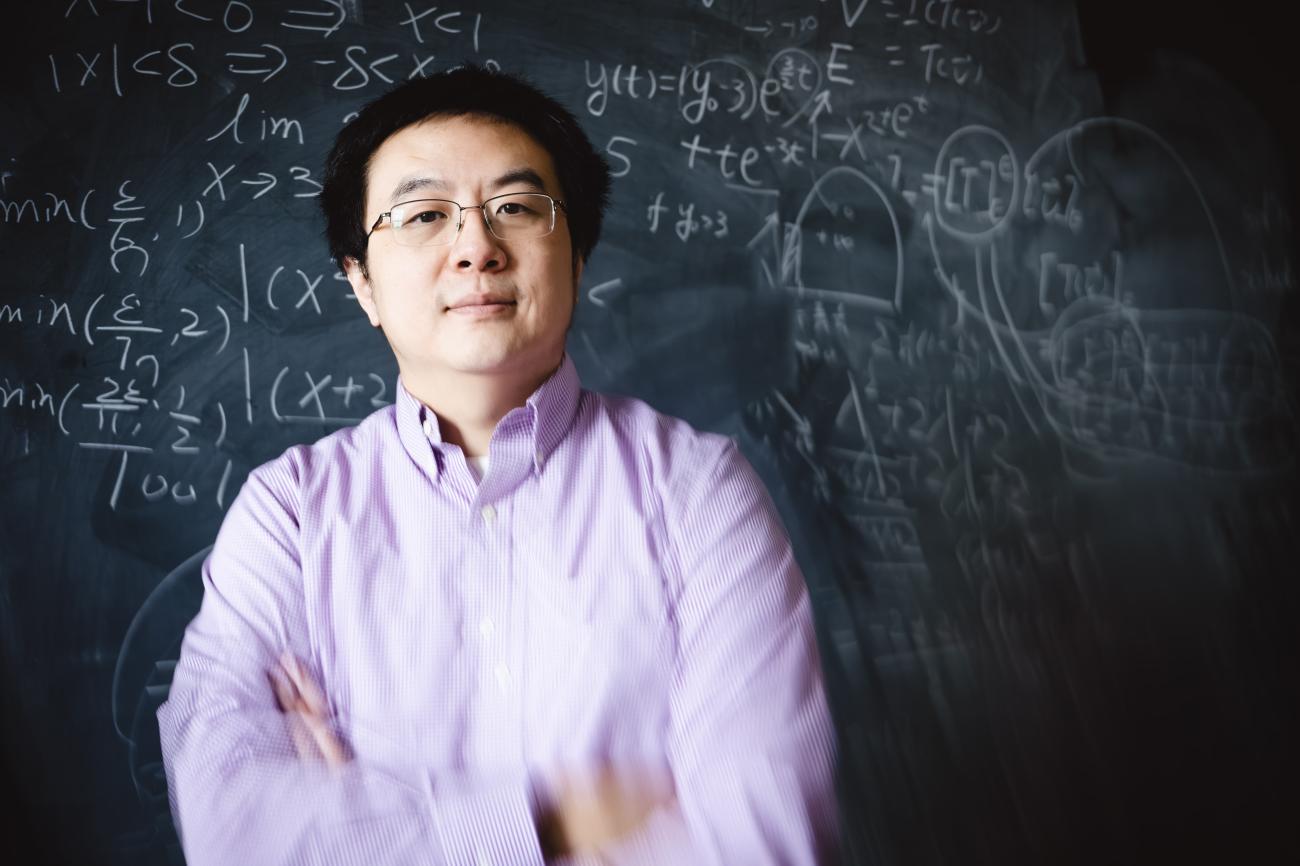Mathematics in Motion
From Differential Equations to Real-World Applications
The problems that captivate mathematician and computational scientist Xianyi Zeng rarely sit still. Whether tracking how water moves around a rapidly accelerating ship, modeling the spread of viral infections through cellular tissue, or understanding why rivers snake and curve across landscapes, his work grapples with systems in constant flux. At their core lie differential equations, the mathematical languages used to describe how things change. Solving these equations, especially when traditional analytical approaches fail, has become his calling.
"I prefer to describe my research as applied mathematics and scientific computing," says Zeng, assistant professor of mathematics. His focus is particularly sharp on hyperbolic conservation laws, equations describing quantities that remain constant even as they flow through space and transform over time. Mass in a closed fluid system, the total number of cells in a biological tissue, energy in a moving fluid — each obeys a conservation principle that Zeng translates into computational methods.
From Theory to Simulation
The Navier-Stokes equations occupy much of Zeng's early work in fluid dynamics. These equations, developed by Claude-Louis Navier and George Gabriel Stokes in 1822, are equations that can be used to determine the velocity vector field that applies to a fluid, given some initial conditions. They arise from the application of Newton's second law in combination with fluid stress (due to viscosity) and pressure terms. The Clay Mathematical Institute offers a $1 million prize to prove their existence, yet rather than pursue analytical proof of their solutions' existence, Zeng took a different path.
"We tackle that problem from a computational point of view," he notes. "We try to find the numerical approximation to the solution before we actually know that there is a solution."
This pragmatic turn reflects years of research in computational fluid dynamics. The equations model air and water in motion, making them indispensable for engineering applications from airplane wing design to ship hull optimization. For more than half a century, mathematicians and engineers have refined numerical schemes to approximate these solutions. But Zeng sees unfinished business. Modern engineering problems, he argues, demand more than isolated solutions. When a ship cuts through water at high speed, the interaction becomes extraordinarily complex. The hull pushes against the ocean. Water splashes upward. Wind catches the spray. The air and water exchange momentum and energy in ways that fundamentally change the ship's behavior. Traditional methods, developed separately for fluid-structure interaction and multiphase flow, prove incompatible when applied together.
"The existing methods in these two areas don't work with each other," Zeng explains. "They face different difficulties, and people have gone completely different routes in order to handle this difficulty, which are incompatible." His NSF-funded research, which concluded recently after yielding seven to eight peer-reviewed papers, addressed this gap by developing unified numerical schemes that handle all these interactions simultaneously.
A Tale of Two Research Threads
Yet Zeng's portfolio spans far more than ships and waves. He devotes roughly equal energy to what he calls "the other half" of his work: developing approximation methods for differential equations themselves, independent of any specific application.
Here, his research centers on Hermite interpolation, a refinement of classical polynomial approximation techniques. Traditional methods encode only point values of a function. Hermite interpolation does something subtler. It matches both the function values and their derivatives at specified points.
"Differential equations, by definition, involve derivatives," Zeng says. "We are trying to build our approximation of both, not only on the point values."
This theoretical insight carries practical weight. Hermite-based methods can achieve greater computational efficiency, a concern that runs through all of Zeng's work, by respecting the derivative information inherent in differential equations. For applications requiring thousands of processors running for weeks to simulate complex flows, efficiency translates directly into feasibility and cost.
"People can make things more complicated from reality, which is going to be more demanding in computing and more demanding in the mathematical methodology development. So, I don't see this field ending in a couple or in several decades."

The breadth of Zeng's collaborations reveals how deeply mathematical principles can unify seemingly disparate fields. His work with biologists and medical researchers on tumor growth modeling and virus infection dynamics draws on the same conservation principles governing fluid flow. Cells divide, differentiate, or succumb to viral attack — yet the total cell count obeys conservation laws. By developing flexible computational tools grounded in these universal principles, Zeng can move seamlessly between problems. "Within one day I can use that to solve that tumor growth problem after addressing a fluid dynamics application."
Perhaps most intriguingly, Zeng collaborates with civil engineers on the meandering of rivers. Winding waterways aren't mere aesthetics; they reflect profound instabilities in how fluids interact with their boundaries. A colleague's experimental facility creates miniature rivers in a laboratory setting, allowing researchers to test how changes in flow conditions alter meandering patterns, while Zeng's group provides mathematical models and numerical tools for preliminary analysis.
The Infrastructure of Discovery
None of this work occurs in isolation from the computational substrate that enables it. Zeng's office contains a machine with 64 processors — sufficient for code development and scaling tests. But for production-scale problems like the Navy-funded ship simulations he worked on as a postdoc at Duke University, thousands of processors running for weeks become necessary.
Zeng's research suggests something deeper: the field itself remains fundamentally open-ended. Although computational fluid dynamics has evolved over 50 years, each advance in computing power and mathematical understanding creates capacity to tackle more complicated problems. Boeing and other aerospace companies still rely on numerical methods developed decades ago because changing operational code carries enormous risk. Yet this inertia doesn't diminish the need for innovation.
As computing paradigms shift — whether toward greater parallelism, new architectures, or speculative quantum approaches — the mathematical methodology must evolve in concert. Today's aerodynamicists consider minute changes on airplane wings or fuselages, knowing even tiny perturbations influence performance. Similarly, engineers designing offshore drilling platforms must account for fluid-structure-air interactions as the structures bob in violent ocean storms.
"People can make things more complicated from reality, which is going to be more demanding in computing and more demanding in the mathematical methodology development," Zeng says. "So, I don't see this field ending in a couple or in several decades."
For mathematicians, engineers, and the industries they serve, that open horizon represents both challenge and opportunity. And Zeng appears content to remain in motion through it, solving problems that refuse to sit still.

